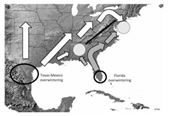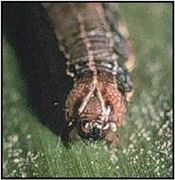Surge Of Fall Armyworms May Affect Pastures And Cover Crops In Kentucky
DR. RAUL T. VILLANUEVA
PRINCETON, KY.
Fall armyworms (Spodoptera frugiperda) do not survive the winter temperatures of Kentucky and surrounding states, and every year there is a northward migration in the continental U.S. These migrant moths originate from populations that overwinter in southern Florida or southern Texas/Mexico.
Fall Armyworm Strains and Migration Pathways
Fall armyworm that feed on different plant species in their overwintering sites are classified as genetically differentiated host-associated strains [of corn (Zea mays L.) or rice (Oryza sativa L.)]. These fall armyworm strains have different migratory pathways. The corn strains that originate in south Texas and Mexico arrive to Western Kentucky around mid-August. Whereas, the rice strain follows a path through the west of the Appalachian Mountain range (Figure 1). Studies show that these two strains hybridize in two distinct geographical zones, in Alabama-Georgia and in New York – New Jersey (Figure 1).
Abundance of Fall Armyworm in Kentucky in 2016
On August 10, 2016, Ms. Patty Lucas (Extension IPM Specialist) checked a pheromone based trap for fall armyworms in Princeton KY, and found less than ten male moths. Then two days later (August 12), she counted more than two hundred male moths in the same trap. Last week the trap counts increased to 479 moths (Figure 2). Also, last week I found some fall armyworms on soybeans in Princeton and Lexington. This week, Clint Hardy, a County Extension Agent for Agriculture and Natural Resources, reported unidentified moths flying everywhere in Davies Co.
Based on historical data, recent reports, and trap counts shown above, it is possible that fall armyworms caused some damage on pastures and cover crops. Bt corn will be not affected. Adult fall armyworms will lay their eggs on grasses. Later it can affect row crops such as sorghum, alfalfa, vegetables and other plants if grasses are not available. The presence of dark patches in pastures may be a sign of the abundance of fall armyworms.
Fall Armyworm Identification and Management
The fall armyworm has three yellow stripes running along the length of its body. Its head is dark brown with a light-colored, inverted “Y” mark on the front (Figure 3). Application of insecticides should be made when fall armyworm larvae are 0.75 inches long or smaller for best results. ∆
DR. RAUL T. VILLANUEVA: Extension Entomologist, University of Kentucky

Figure 1. Migratory pathways of the fall armyworm strain from corn (white arrows) or rice strain (grey arrows).
Lined circles indicate approximate locations of “hybrid zones” where the two migratory pathways appear to overlap.
Notice that migrations follows the major elevations of the Appalachian Mountain range.
(Taken from Nagoshi et al. 2012)

Figure 2. Trap counts of fall armyworms in Princeton and Lexington Kentucky.
Notice the high numbers of moths caught in Princeton compared with Lexington.

Figure 3. Fall armyworm showing inverted ‘Y’ on the head.
Photo credit Ric Bessin, UK